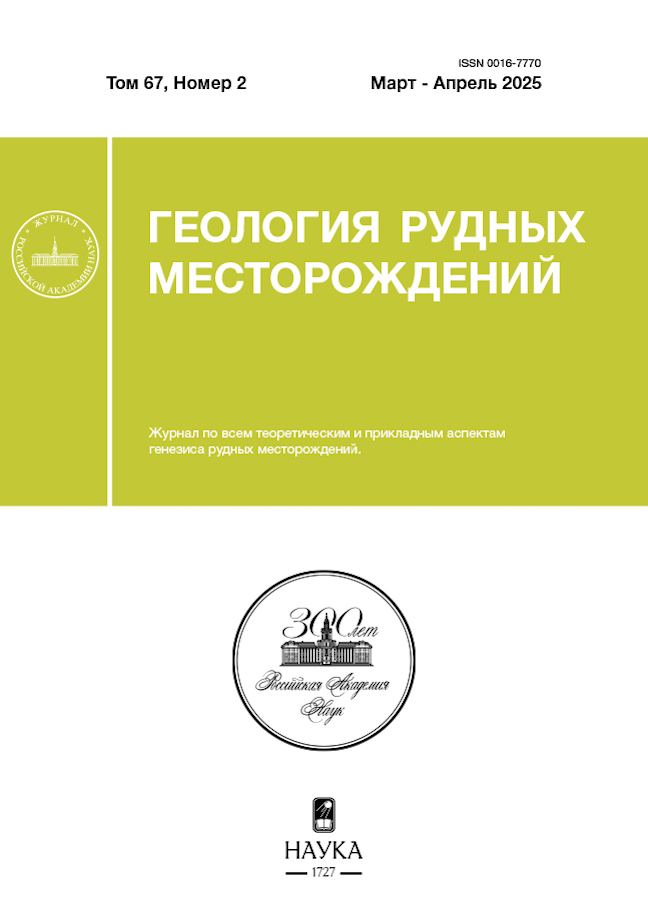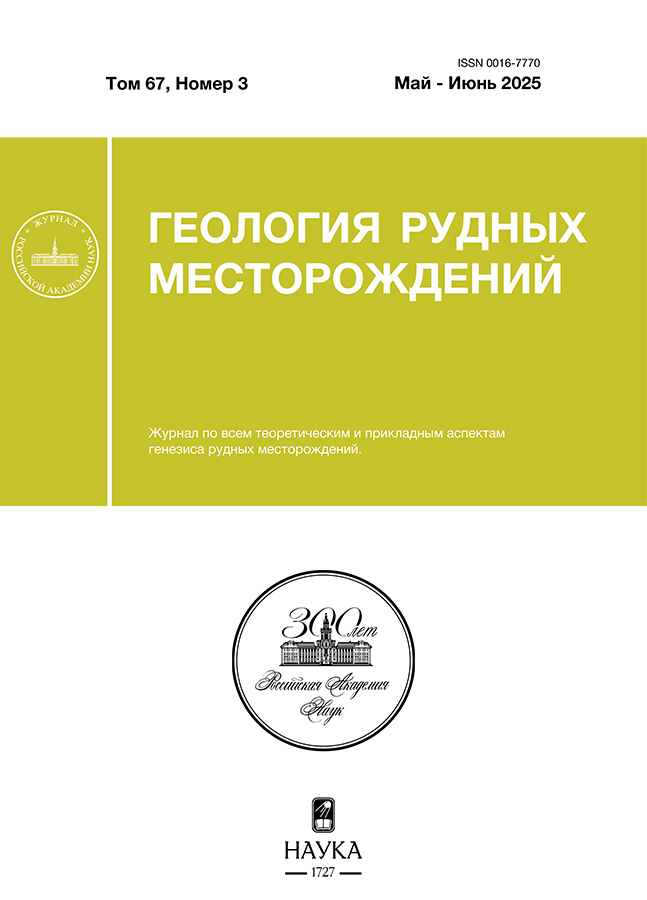Vol 67, No 3 (2025)
Articles
Петрология и рудообразование. К 100-летию А. А. Маракушева
 227-232
227-232


Orogenic gold-ore deposits of Taimyr-Severnaya Zemlya province, Russia
Abstract
The paper presents geological and genetic typification of gold orogenic mineral deposits of Taimyr-Severnaya Zemlya associated with accretionary processes in the Precambrian and collisional ones in the Late Paleozoic. Gold-bearing mineral associations of gold-quartz and gold-sulfide-quartz deposits of accretionary formations of the Precambrian Shrenk-Faddei (Yasnenskoe, Malinovskoe) and collisional Mininsko-Bolshevistskaya (Nizhnelitkenskoe, Vidimoe, Nerpichye, Konechninskoe) mineragenic zones have been studied. Studies of fluid inclusions have made it possible to establish the main RTX parameters of gold ore mineralization formation. The main ore-generating processes for the orogenic-accretionary epoch are greenschist regional-dislocation metamorphism; for the orogenic-collisional epoch - plutonogenic-metamorphogenic and plutonogenic granitoid magmatism. The obtained data indicate the possibility of identifying two new geological and economic regions in the Central sector of the Russian Arctic.
 233-258
233-258


Mineral composition of rare-metal metasomatic rocks of the Ufaley metamorphic complex (vein 175 of the Kyshtym quartz-vein deposit, Slyudorudnik, South Urals)
Abstract
The article considers the geological position and mineral composition of rare-metal (TR) metasomatites with a pegmatoid structure and forming lenticular bodies. TR metasomatites are spatially and genetically related to carbonatites and form single bodies. The latter are spatially related and have the same geological position with industrial bodies of vein, granular quartz. Unlike cabonatites, metasomatites are crushed and boudinated. The uniqueness of metasomatites is due to unusually large xenotime crystals. Most minerals involved in the structure of metasomatites contain abnormally high isomorphic impurities of Y. In the composition of yttrium-bearing epidote and yttrium-bearing titanite, its amount is slightly more than 8 wt. % Y2O3. Fergusonite-(Y) and a mineral whose composition approaches the idealized formula YAlSiO5 are present as inclusions in yttrium titanite. In apatite-II, formed in certain areas during recrystallization (granulation) of apatite-I, the total content of yttrium and heavy rare earth elements significantly exceeds 10 wt. %. Fergusonite-(Y) and a microinclusion, the composition of which corresponds to a complex oxide with the formula Ca2Y2O5, are present as inclusions at the grain boundary. The unusual composition of metasomatites and the specific structure of TR-metasomatites indicate a long process of their formation and metasomatic nature. At present, metasomatite lenses occur in rocks that have undergone metamorphism at the level of amphibolite facies.
 259-286
259-286


Formation conditions of the Yugo-Konevskoe and Porokhovskoe tungsten deposits (Southern Urals) based on microthermocryometry and mineralogical thermometry data
Abstract
The article is devoted to the assessment of the formation conditions of the Yugo-Konevskoye and the Porokhovskoye deposits belonging to the same ore zone, localized in granites and in a metamorphosed volcanogenic-sedimentary sequence, respectively, and separated by a large thrust. According to the results of the study of fluid inclusions in quartz, the formation of quartz ± fluorite ± muscovite veins with hubnerite at both deposits was under similar conditions at minimum true temperatures of 245–540 °C and a pressure of ~ 350 bar, from carbon dioxide -water fluids of sodium-chloride composition with an admixture of KCl, KF and Ca and Mg carbonates, with a salt concentration of 0.54 to 16.13 wt. % NaCl-eq. CO2 predominates in the gas phase and impurities of CH4, N2 and H2S are recorded. The similarity of the mineral composition, fluid and muscovite composition in the ore veins indicates a single source of ore-bearing fluid for both deposits and an insignificant influence of the host rocks on it. The simultaneous presence of low-mineralized inclusions and inclusions with a solid phase indicates a phase separation, which is more pronounced at the Yugo-Konevskoye deposit. Late quartz in the skarns of the Porokhovskoye deposit was formed at lower temperatures than the ore veins and from solutions that contained a sulfate component, reflecting the probable assimilation of limestones from the host strata during skarnification. Low pressures estimated from FI are due to the formation of ore veins as a result of brittle deformations of consolidated rocks. The obtained PTX parameters of the fluids correspond to those characteristic of greisen formation objects, falling into the relatively low-pressure and low-temperature region.
 287-314
287-314


The estimation of prospectivity of porphyry Cu-Mo-Au mineralization based on biotite composition (on example of the Shakhtama Mo-porphyry and Bystrinsky Cu-Au-Fe-porphyry-skarn deposits, eastern Transbaikalia, Russia)
Abstract
Economical mineralization of the Bystrinsky Сu-Аu-Fе-porphyry-skarn and Shakhtama Мо-роrрhуrу deposits is confined to multiphase granitoid plutons of the Middle-Late Jurassic Shakhtama complex. The composition of biotite from magmatic rocks of ore-bearing and barren intrusions has been studied to identify the specifics of Cu-Au porphyry and Mo porphyry mineralization. The magmatic origin of the studied biotite and the absence of secondary processes have been demonstrated. Biotite from ore-bearing intrusions of the Bystrinsky and Shakhtama deposits is characterized by high MgO content (>15 wt.%). Low values of IV(F) and IV(F/Cl) calculated from biotites of ore-bearing intrusions indicate enrichment of F and Cl in the fluid phase. It has been determined that the rocks of the ore stocks were formed from oxidized magmas. New data showed that published diagrams for biotite composition are incorrect for separating ore-bearing and barren rocks. Linear discriminant analysis was performed on the obtained biotite compositions of the Bystrinsky and Shakhtama deposits and the author's new discriminatory diagram was proposed. Unlike published diagrams, new discriminant diagram allows to be distinguished potentially ore-bearing intrusive complexes (and their type of mineralization) from barren intrusive complexes by biotite composition and can be used with other indicator minerals in the search for porphyry mineralization.
 315-336
315-336


U-Pb age and zircon geochemistry of fertility-reduced granite on example of the Tam Dao tin ore district, Northeast Vietnam
Abstract
 337-375
337-375


Ore-localizing and ore-preserving factor of lightening of the ore-bearing alluvial sediments in the uranium deposits of the Khiagda ore field
Abstract
The throughout lightening up to the whitening of basement granites, ore-bearing alluvial sediments, volcanogenic-sedimentary strata and fracture zones of plateau basalts are shown on an example of Vershinnoye uranium ore deposit of Khiagda ore field of Vitimskiy uranium ore region. The contribution of deep carbonated waters with high reducing capacity to this process is shown. The ore-localizing and ore-preserving role of the ore-bearing alluvial sediments lightening process is proofed. The key similarities and differences of young (Vitim type) and ancient (Dalmatov type) paleovalley deposits in contrast to the classical bedded-infiltration deposits of the Tien Shan uranium megaprovince are shown.
 376-394
376-394












